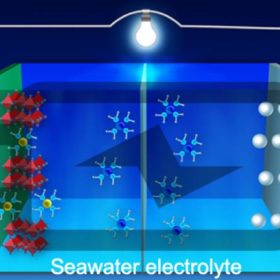Big solar already pulling its weight on emission reduction – especially in Chile
Following a disappointing COP27 climate change summit in November, solar industry veteran Philip Wolfe reviews the contribution utility-scale PV is starting to make to emissions reduction.
Seawater aqueous battery based on alloy of zinc and manganese
Scientists in the United States developed a new anode for aqueous batteries. A working battery utilizing this anode, with seawater as an electrolyte, demonstrated impressive energy density, and remained stable after 1,000 hours of high current cycling. The group is already discussing the potential of their approach in large-scale manufacturing.
PG&E, Tesla start building world’s biggest battery
The 182.5 MW/730 MWh Moss Landing energy storage system could eventually be expanded to 1.1 GWh – putting it on track to overshadow Tesla’s massive Hornsdale project in Australia.
The week in perovskites
As a focus of research at leading institutes the world over, new developments in the perovskite field come thick and fast almost every week. From x-ray observations on a nanoscale to financing and plans for mass production, pv magazine is bringing together some of the most exciting developments of recent weeks.
US module shipments down in January and February
While the volume of combined imports and exports slumped from almost 2 GW in December to 1.49 GW in January and 1.36 GW in February, the price per kilowatt rose dramatically in the second month of the year.
The world will add 142 GW of new solar this year
IHS Markit has predicted another year of global solar growth but a peek behind the headline figures shows uncertainty dogging the markets of China and India, two of the most important markets and biggest polluters.
The year in solar, part III: Battery breakthroughs, inverter trouble, sustainable role models and new tech
Storage has long been expected to be the handmaiden of a renewable energy world and its long awaited advances started to finally emerge in the third quarter as researchers posited R&D achievements ranging from potentially potent tungsten disulfide nanotubes to the business case for 10-year solar panels.
AI selecting best solar perovskites
A U.S. research team has used machine learning to optimize material composition and predict the design strategies and performance of perovskite solar cells. The researchers analyzed 2,000 peer-reviewed perovskite publications and collected more than 300 data points.
Hanwha Q Cells opens largest solar factory in the Western Hemisphere
The 300,000 sq ft factory in Dalton, Georgia has the capacity to produce 12,000 PV modules per day – 1.7 GW worth annually for panels able to produce the same peak generating capacity as the Hoover Dam.
The US tops 37.9 GW of large scale solar
That record figure of utility scale PV was under contract at the end of June with 8.7 GWdc under construction. However, installation levels fell slightly, year-over-year.









